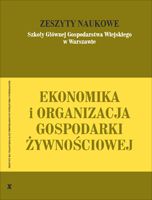Quantitative analysis of food consumption by Polish families with the utilization of their classification with the use of neural networks
Main Article Content
Abstract
Data from surveys carried out by GUS permit to state that there is large individual variability in consumption of food by the Polish population. However, traditional partitioning of households, for example, according to income or dwelling place does not fully explain this variability. It was assumed that neural networks as a new research tools can shade more light is respect to consumption of food in concentrated households. The use of neural networks of the Kohonen type enabled the separation of 4 basic concentrations of households differing in the level of food consumption as well as in the contribution of various products. This partitioning explained at a high level the variability in food consumption (the average correlations coefficient of groups of products examined reached the level of 0.6). Moreover this partitioning gave the opportunity to further analyze relatively homogenous households that clarity differ with each other.
Article Details
How to Cite
Laskowski, W. (2000). Quantitative analysis of food consumption by Polish families with the utilization of their classification with the use of neural networks. Zeszyty Naukowe SGGW - Ekonomika I Organizacja Gospodarki Żywnościowej, (42), 227–237. https://doi.org/10.22630/EIOGZ.2000.42.85
References
HERTZ J., KROGH A., PALMER R., 1995: Wstęp do teorii obliczeń neuronowych, Wydawnictwa Naukowo-Techniczne, Warszawa.
KOWRYGO B., 2000: Studium wpływu gospodarki rynkowej na sferę żywności i żywienia w Polsce, Wydawnictwo SGGW, Warszawa.
LASKOWSKI W., 2000: Sieci neuronowe w analizach statystycznych; Wiadomości Statystyczne 7, GUS, Warszawa.
OSOWSKI S., 1996: Sieci neuronowe, Wydawnictwa Naukowo-Techniczne, Warszawa.
TADEUSIEWICZ R., 1993: Sieci neuronowe, Akademicka Oficyna Wydawnicza RM, Warszawa.
Statistics
Downloads
Download data is not yet available.
Recommend Articles
Most read articles by the same author(s)
- Barbara Kowrygo, Wacław Laskowski, Predicted changes in food consumption as a basis for sustainable development of food economics in Poland , Zeszyty Naukowe SGGW - Ekonomika i Organizacja Gospodarki Żywnościowej: No. 41 (2000)
- Wacław Laskowski, Some Correlation and Preferences in Income Disposal by the Households , Zeszyty Naukowe SGGW - Ekonomika i Organizacja Gospodarki Żywnościowej: No. 44 (2001)
- Ewa Świstak, Wacław Laskowski, Food consumption changes in rural areas and their determinants , Zeszyty Naukowe SGGW - Ekonomika i Organizacja Gospodarki Żywnościowej: No. 114 (2016)
- Wacław Laskowski, Comparisons of lncome of Agricultural Households with lncome of Other Socio-Professional Groups , Zeszyty Naukowe SGGW - Ekonomika i Organizacja Gospodarki Żywnościowej: No. 33 (1998)
- Wacław Laskowski, THE CHANGES OF THE LEVEL OF FOOD CONSUMPTION IN POLAND , Zeszyty Naukowe SGGW - Ekonomika i Organizacja Gospodarki Żywnościowej: No. 67 (2008)
- Wacław Laskowski, The Incomes of the Polish Population and their Disposal Structure in the Light of the Survey of Household Budgets , Zeszyty Naukowe SGGW - Ekonomika i Organizacja Gospodarki Żywnościowej: No. 43 (2001)
- Wacław Laskowski, Food Consumption by Polish Families in the Light of the Results of Research on Household Budgets and Food Recommendations , Zeszyty Naukowe SGGW - Ekonomika i Organizacja Gospodarki Żywnościowej: No. 38 (2000)





